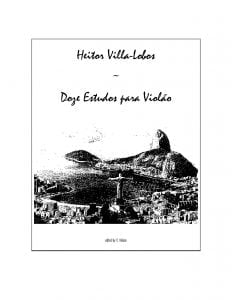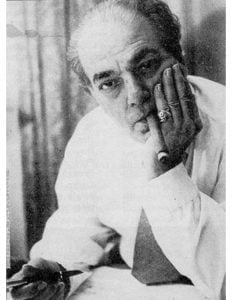Villa-Lobos: 12 Études for Guitar, W235 (sheet music)
Villa-Lobos: 12 Etudes, W235 – Etude No.5 In C Major with sheet music (partitura) in our Library.
Narciso Yepes, Guitar

Browse in the Library:
Heitor Villa-Lobos
Heitor Villa-Lobos (Rio de Janeiro, March 5, 1887, November 17, 1959) was a Brazilian conductor and composer. His music was influenced by both Brazilian folk music and classical music. European.
He received some musical instruction from his father. Already before 1899, the year of his father’s death, Villa-Lobos had begun to dedicate himself to music as a professional. He performed as a café musician playing the cello, although he was also an occasional guitar, clarinet and piano player.
Villa-Lobos also had a second career as a pedagogue of the music of his country. He designed a complete system of musical instruction based on the rich musical culture of Brazil and rooted in a deep and always explicit patriotism. He composed choral music for huge boys’ school choirs, often to adaptations of folk material. His heritage in today’s Brazil, uniform among the new generations, is raised with the samba school as a strong sense of pride and love intertwined with similar feelings for his country.
Heitor Villa-Lobos was born on March 5, 1887, in the Laranjeiras neighborhood of Rio de Janeiro. He was the son of Raúl Villa-Lobos, a librarian and amateur musician, and Noêmia Villa-Lobos, a housewife.
In 1905, Villa-Lobos made the first of his trips to the northeastern states of Brazil, gathering information on the folk music of those territories. Villa-Lobos himself created a certain halo of mystery around these trips. To some, his narrative of adventures with cannibalistic tribes of the Northeast is unreliable. He then studied at the National Institute of Music in Rio de Janeiro, although his compositional style never fell into any academic norm. His music always remained personal and idiosyncratic. As Villa-Lobos said many years later: ‘My music is natural, like a waterfall.’ He also said: ‘One foot in the academy, and you change for the worse.’

After other ethno-musical trips to the interior of the Amazon basin in 1912, Villa-Lobos returned to Rio de Janeiro. There, on November 13, 1915—at the age of 28—he presented a concert of his new music. In 1923, due to his merits, he won a government scholarship to study in Paris. Upon his return in 1930, Villa-Lobos was appointed director of music education in Rio de Janeiro.
In 1940 Villa-Lobos discovers a young guitarist in Montevideo (Uruguay): Abel Carlevaro, who draws his attention for his high musical level, invites him to Rio de Janeiro to introduce him to his works for guitar, gives him lessons on his music for several months, witnesses the premiere by Carlevaro of some of his works, gives him manuscripts of several of his Studies and Preludes and shares with him his compositional ideas and his discoveries of the music of deep Brazil.
One of his favorite singers was the Brazilian soprano Bidu Sayão, with whom he had a thirty-eight-year artistic relationship. In 1944, Villa-Lobos made a trip to the United States, where he was appreciated as a director and as a critic. Some American orchestras commissioned him for important new works, and he even wrote the music for a Hollywood film entitled Green Mansions in 1959, directed by the famous actor Mel Ferrer and starring Ferrer himself and Audrey Hepburn.
The 1940s were a period of triumph on the international scene. As composer and director of his own music, Villa-Lobos was feted in important cities such as Los Angeles, New York and Paris. Despite his world travels, his home was always in Rio de Janeiro, where he died in 1959.
Heitor Villa-Lobos was buried in the São João Batista cemetery (in Rio de Janeiro).
Villa-Lobos works
Villa-Lobos was a notoriously prolific composer. Many works are arrangements of previous works. Especially in his last years, Villa-Lobos made a large number of recompositions.
The works mentioned below represent his musical heritage. His music is widely distributed in the world due to the existing recordings, and the concerts that are performed. Even the symphonies are now available in one comprehensive recording. Exceptions include the Nonet and the operas.
Among the most popular works of Villa-Lobos are the Bachianas brasileiras. Bachiana No. 5 is one of the best known; Written for voice and eight cellos, it is not uncommon for it to be performed in many other instrumental combinations.
His music for guitar can be cited as the Preludes (particularly famous No. 1, subtitled ‘Melodía lírica’ and composed in 1940), the Estudios and the Choros, among which Choro No. 1 is very popular. That Choro No. 13 of 1920 influenced one of the most famous tangos, Malena (of 1942) in its main melodic line, becoming one of the first examples of academic music influencing popular music in the 20th century.
It is also important to mention the String Quartet series.
Among the most important titles he received is the Doctor Honoris Causa of New York University and that of founder and first president of the Brazilian Academy of Music.4 In 1986, Heitor Villa-Lobos had his face printed on the five hundred bills Crusaders.
Currently, it has a room named in its honor in the National Theater of Brasilia and, among other tributes in streets and squares throughout Brazil, there is also the Villa-Lobos Park in São Paulo. He was named full member of the National Academy of Fine Arts of Argentina.
